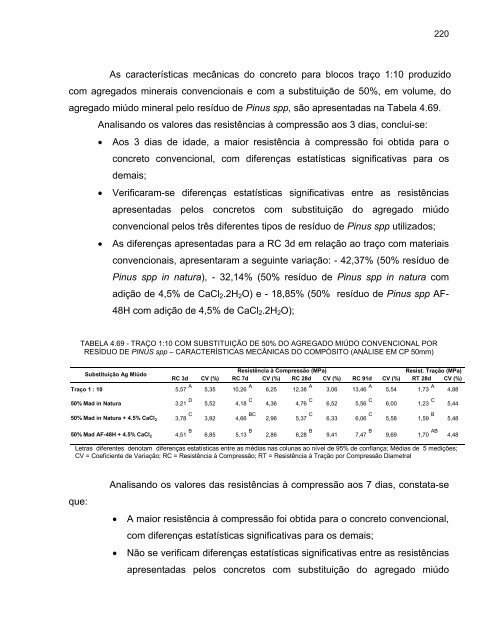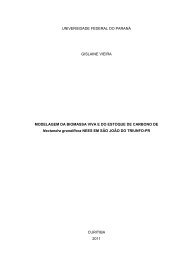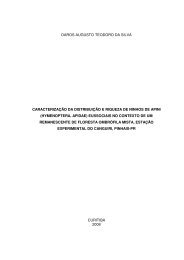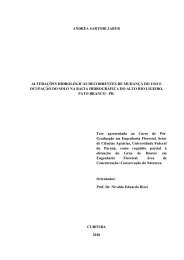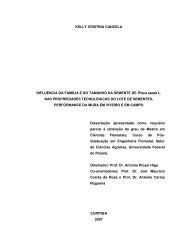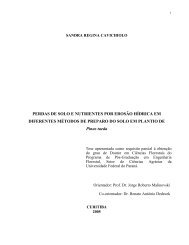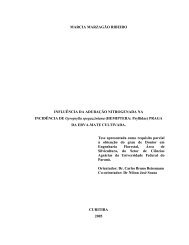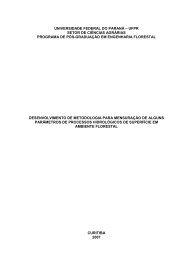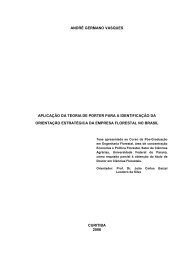Tese em PDF - departamento de engenharia florestal - ufpr ...
Tese em PDF - departamento de engenharia florestal - ufpr ...
Tese em PDF - departamento de engenharia florestal - ufpr ...
You also want an ePaper? Increase the reach of your titles
YUMPU automatically turns print PDFs into web optimized ePapers that Google loves.
As<br />
com agregados<br />
minerais convencionais e com a substituição <strong>de</strong> 50%, <strong>em</strong> volume, do<br />
agregado miúdo mineral pelo resíduo <strong>de</strong> Pinus spp,<br />
são apresentadas na Tabela 4.69.<br />
Analisando<br />
os valores das resistências à compressão aos 3 dias, conclui-se:<br />
220<br />
• Aos<br />
3 dias <strong>de</strong> ida<strong>de</strong>, a maior resistência à compressão foi obtida para o<br />
concreto convencional,<br />
com diferenças estatísticas significativas para os<br />
• Verificaram-se<br />
diferenças estatísticas significativas entre as resistências<br />
•<br />
apresentadas<br />
pelos concretos com substituição do agregado miúdo<br />
convencional pelos três diferentes tipos <strong>de</strong> resíduo <strong>de</strong> Pinus spp utilizados;<br />
convencionais,<br />
apresentaram a seguinte variação: - 42,37% (50% resíduo <strong>de</strong><br />
Pinus<br />
spp in natura), - 32,14% (50% resíduo <strong>de</strong> Pinus spp in natura com<br />
adição<br />
<strong>de</strong> 4,5% <strong>de</strong> CaCl2.2H2O) e - 18,85% (50% resíduo <strong>de</strong> Pinus spp AF-<br />
48H com adição <strong>de</strong> 4,5% <strong>de</strong> CaCl2.2H2O);<br />
TABELA 4.69 - TRAÇO 1:10 COM SUBSTITUIÇÃO DE 50% DO AGREGADO MIÚDO CONVENCIONAL POR<br />
RESÍDUO DE PINUS spp – CARACTERÍSTICAS MECÂNICAS DO COMPÓSITO ( ANÁLISE EM CP 50mm)<br />
Substitu ição Ag<br />
Miúdo<br />
Traço 1 : 10<br />
50% Mad in Natura<br />
50% Mad AF-48H + 4.5% CaCl2 características mecânicas do concreto para blocos traço 1:10 produzido<br />
d<strong>em</strong>ais;<br />
As diferenças apresentadas para a RC 3d <strong>em</strong> relação ao traço com materiais<br />
Resistência à Compressão (MPa)<br />
Resist. Tração (MPa)<br />
RC 3d CV (%) RC 7d CV (%) RC 28d CV (%) RC 91d CV (%) RT 28d CV (% )<br />
A<br />
5,57 5,35<br />
A<br />
10,26 6,25<br />
A<br />
12,38 3,06<br />
A<br />
13,46 5,54<br />
A<br />
1,73 4,88<br />
D C C C C<br />
3,21 5,52 4,18 4,36 4,76 6,52 5,56 6,00 1,23 5,44<br />
C BC C C B<br />
50% Mad in Natura + 4.5% CaCl2 3,78 3,92 4,66 2,96 5,37 6,33 6,06 5,58 1,59<br />
B B B B AB<br />
4,51 6,85 5,13 2,86 6,28 9,41 7,47 9,69 1,70 4,48<br />
Letras diferentes <strong>de</strong>notam diferenças estatísticas entre as médias nas colunas ao nível <strong>de</strong> 95% <strong>de</strong> confiança; Médias <strong>de</strong> 5 medições;<br />
CV = Coeficiente <strong>de</strong> Variação; RC = Resistência à Compressão; RT = Resistência à Tração por Compressão Diametral<br />
que:<br />
Analisando os valores das resistências à compressão aos 7 dias, constata-se<br />
•<br />
•<br />
A maior resistência à compressão foi obtida para o concreto convencional,<br />
com diferenças estatísticas significativas<br />
para os d<strong>em</strong>ais;<br />
Não se verificam diferenças estatísticas significativas entre as resistências<br />
apresentadas pelos concretos com substituição do agregado miúdo<br />
5,48


